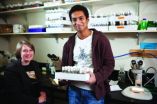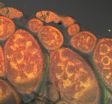(Press-News.org) Athens, Ga. – When Li Tan approached his colleagues at the University of Georgia with some unusual data he had collected, they initially seemed convinced that his experiment had become contaminated; what he was seeing simply didn't make any sense.
Tan was examining some of the sugars, proteins and polymers that make up plant cell walls, which provide the structural support and protection that allow plants to grow. Yet his samples contained a mixture of sugars that should not be present in the same structure.
However, Tan was convinced that his samples were pure so he and Debra Mohnen, who heads the lab, met again to pore over the data. They came to realize that there were hints in the data of a connection between two different types of cell wall glycans (sugars) and a specific cell wall protein known as arabinogalactan protein. This connection is not known to exist and does not conform to the commonly held scientific definitions of plant cell wall structure.
But Tan and Mohnen, who both work as part of the BioEnergy Science Center, one of three U.S. Department of Energy-funded research centers, were persistent, and they, along with an interdisciplinary team of chemists, molecular biologists and plant experts at UGA, began searching for answers. What they found could redefine our understanding of basic plant biology, and it may lead to significant improvements in the growth and processing of biofuel crops.
"This is totally new," said Tan, a research scientist in the Complex Carbohydrate Research Center and lead author of a paper detailing the group's findings published Jan. 31 in an early online edition of The Plant Cell. "We had never seen linkages between these structures before, and we had to develop a variety of new tests to prove that what we saw was not simply a mistake or a contamination."
The scientific community generally agrees that complex sugars like pectin and xylan, which allow for cell wall structure, extension and growth, exist in separate networks from cell wall proteins. But the UGA researchers have identified a direct and indisputable link between these two domains.
"What this means is that plant scientists' view of the plant cell wall is at least partially wrong," said Mohnen, professor of biochemistry and molecular biology and a member of UGA's Complex Carbohydrate Research Center. "There have been hints over the last 30 or 40 years that this link might exist, but no one has been able to prove it until now."
The discovery has many far-reaching implications beyond the ways it may change biology textbooks. As concerns about the reality of global climate change continue to rise, scientists are working diligently to find useful alternatives to fossil fuel-derived energy.
Biofuels created from cultivated crops like trees and grasses show great promise as a carbon-neutral source of ethanol, but converting plants into fuel that might be used to power automobiles or create heat for homes has proven difficult. Millions of years of evolution have made plants resistant to breakdown, and the sugars needed for fermentation into ethanol are locked inside their complex cell walls.
But Tan and Mohnen are hopeful that their discovery combined with additional research will reveal many of the secrets of plant cell wall architecture and function, making them easier to break down or perhaps opening the doors for engineered plants that will work better as a feedstock for the biofuels industry and as better agricultural products.
"The applications that will emerge from this discovery are enormous," said Mohnen. "It's all going to stem from a refined understanding of how plants are put together and how they are made, but once we know that, we can start modifying them to make them perform in ways that are most advantageous to us."
"We've only just scratched the surface," she said. "But once we investigate this further and we understand the plant exceptionally well, the sky's the limit."
###
The research was funded through grants from the National Science Foundation and by the BioEnergy Science Center.
Complex Carbohydrate Research Center
The Complex Carbohydrate Research Center was founded at the University of Georgia in 1985 and is one of only three centers worldwide dedicated to the study of complex carbohydrates, which play critical roles in cellular communication, gene expression, immunology, organism defense mechanisms, growth and development. The 140,000-square-foot facility is home to 17 interdisciplinary research groups, including four federally designated centers for carbohydrate research. In addition to UGA research projects, the center also provides analytical services and training to university, government and industrial scientists interested in complex carbohydrate molecules. For more information about the center, see http://ccrc.uga.edu.
Writer: James Hataway, 706/542-5222, jhataway@uga.edu
Contact: Debra Mohnen, 706/542-4458, dmohnen@ccrc.uga.edu
Newly discovered plant structure may lead to improved biofuel processing
2013-02-05
ELSE PRESS RELEASES FROM THIS DATE:
A spiral galaxy with a secret
2013-02-05
Despite its appearance, which looks much like countless other galaxies, Messier 106 hides a number of secrets. Thanks to this image, which combines data from Hubble with observations by amateur astronomers Robert Gendler and Jay GaBany, they are revealed as never before.
At its heart, as in most spiral galaxies, is a supermassive black hole, but this one is particularly active. Unlike the black hole at the centre of the Milky Way, which pulls in wisps of gas only occasionally, Messier 106's black hole is actively gobbling up material. As the gas spirals towards the black ...
Kaiser Permanente's anti-obesity interventions in schools show signs of success
2013-02-05
OAKLAND, Calif., February 5, 2013 – Community-based efforts to change the environment are proving to be an effective way of encouraging more physical activity and nutrition among school-age children, according to findings announced today from Kaiser Permanente. Researchers examined a series of Kaiser Permanente community-based obesity prevention interventions in adults and children and found that the more effective obesity prevention interventions were those that were "high dose" – reaching large populations with greater strength – and those that focused specifically on ...
21 minutes to marital satisfaction
2013-02-05
EVANSTON, Ill. --- Marital satisfaction -- so critical to health and happiness – generally declines over time. A brief writing intervention that helps spouses adopt a more objective outlook on marital conflict could be the answer.
New Northwestern University research shows that this writing intervention, implemented through just three, seven-minute writing exercises administered online, prevents couples from losing that loving feeling.
"I don't want it to sound like magic, but you can get pretty impressive results with minimal intervention," said Eli Finkel, lead author ...
Achilles heel: Popular drug-carrying nanoparticles get trapped in bloodstream
2013-02-05
ANN ARBOR—Many medically minded researchers are in hot pursuit of designs that will allow drug-carrying nanoparticles to navigate tissues and the interiors of cells, but University of Michigan engineers have discovered that these particles have another hurdle to overcome: escaping the bloodstream.
Drug delivery systems promise precision targeting of diseased tissue, meaning that medicines could be more effective at lower doses and with fewer side effects. Such an approach could treat plaques in arteries, which can lead to heart attacks or strokes.
Drug carriers would ...
Biologists map rare case of fitness-reducing interaction in nuclear, mitochondrial DNA
2013-02-05
BLOOMINGTON, Ind. -- A team of biologists from Indiana University and Brown University believes it has discovered the mechanism by which interacting mutations in mitochondrial and nuclear DNA produce an incompatible genotype that reduces reproductive fitness and delays development in fruit flies.
The new research, led by IU biologists Kristi Montooth and Colin Meiklejohn and including former IU undergraduate researcher Mo Siddiq, describes the cause and consequences of an interaction between the two genomes that co-exist within eukaryotic cells. Animal mitochondrial ...
EARTH: Moon could have formed from Earth after all
2013-02-05
Alexandria, VA –Scientists are revisiting the age-old question of how Earth's moon formed with the development of two new models that work out the complicated physics of planetary collisions. The idea of a moon-forming collision is not new: The Giant Impact Theory put forth in the 1970s suggested that the moon resulted from a collision with a protoplanet approximately half the size of ancient Earth. But the physics underlying such a collision implied that the moon should be made up of debris mostly from the protoplanet. Since then we've discovered the moon is instead very ...
Mitochondrial mutations: When the cell's 2 genomes collide
2013-02-05
PROVIDENCE, R.I. [Brown University] — Diseases from a mutation in one genome are complicated enough, but some illnesses arise from errant interactions between two genomes: the DNA in the nucleus and in the mitochondria. Scientists want to know more about how such genomic disconnects cause disease. In a step in that direction, scientists at Brown University and Indiana University have traced one such incompatibility in fruit flies down to the level of individual nucleotide mutations and describe how the genetic double whammy makes the flies sick.
"This has relevance to ...
Old age offers no protection from obesity's death grip
2013-02-05
Obesity kills, giving rise to a host of fatal diseases. This much is well known. But when it comes to seniors, a slew of prominent research has reported an "obesity paradox" that says, at age 65 and older, having an elevated BMI won't shorten your lifespan, and may even extend it. A new study takes another look at the numbers, finding the earlier research flawed. The paradox was a mirage: As obese Americans grow older, in fact, their risk of death climbs.
Ryan Masters, PhD, and Bruce Link, PhD, at Columbia University's Mailman School of Public Health, in collaboration ...
Giving transplanted cells a nanotech checkup
2013-02-05
Researchers at Johns Hopkins have devised a way to detect whether cells previously transplanted into a living animal are alive or dead, an innovation they say is likely to speed the development of cell replacement therapies for conditions such as liver failure and type 1 diabetes. As reported in the March issue of Nature Materials, the study used nanoscale pH sensors and magnetic resonance imaging (MRI) machines to tell if liver cells injected into mice survived over time.
"This technology has the potential to turn the human body into less of a black box and tell us if ...
Next-gen e-readers: Improved 'peacock' technology could lock in color for high-res displays
2013-02-05
ANN ARBOR—Iridescence, or sheen that shifts color depending on your viewing angle, is pretty in peacock feathers. But it's been a nuisance for engineers trying to mimic the birds' unique color mechanism to make high-resolution, reflective, color display screens.
Now, researchers at the University of Michigan have found a way to lock in so-called structural color, which is made with texture rather than chemicals. A paper on the work is published online in the current edition of the Nature journal Scientific Reports.
In a peacock's mother-of-pearl tail, precisely arranged ...



